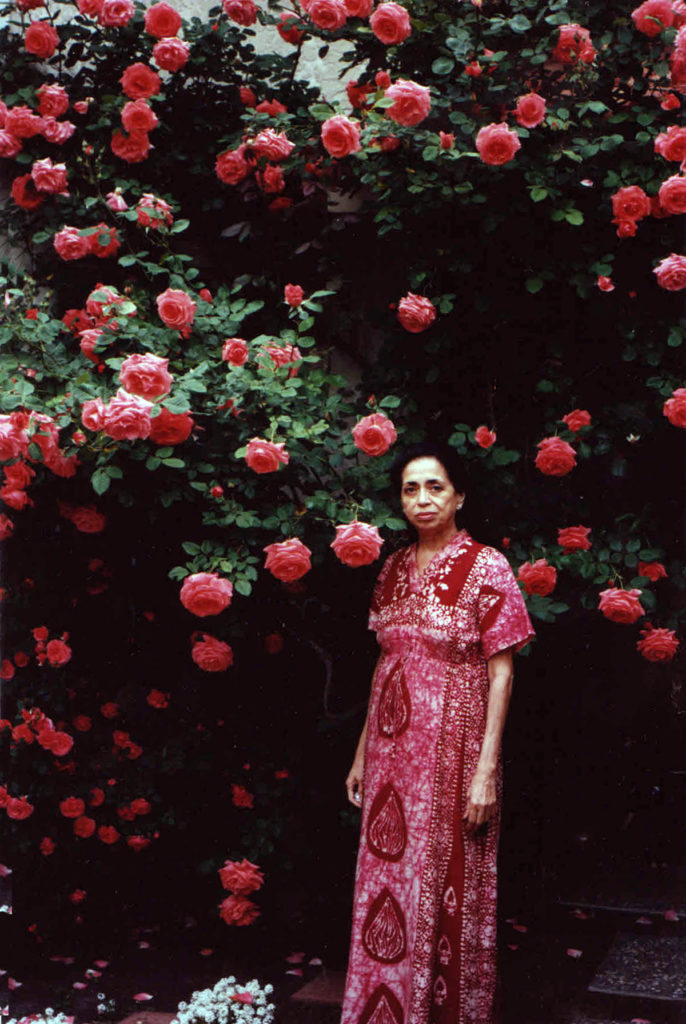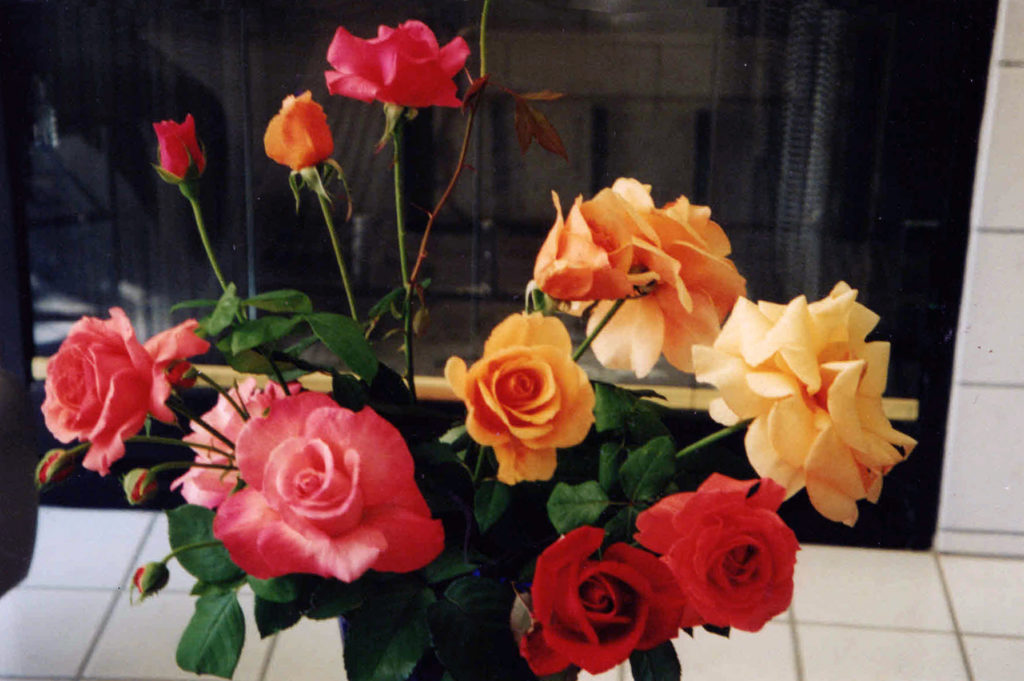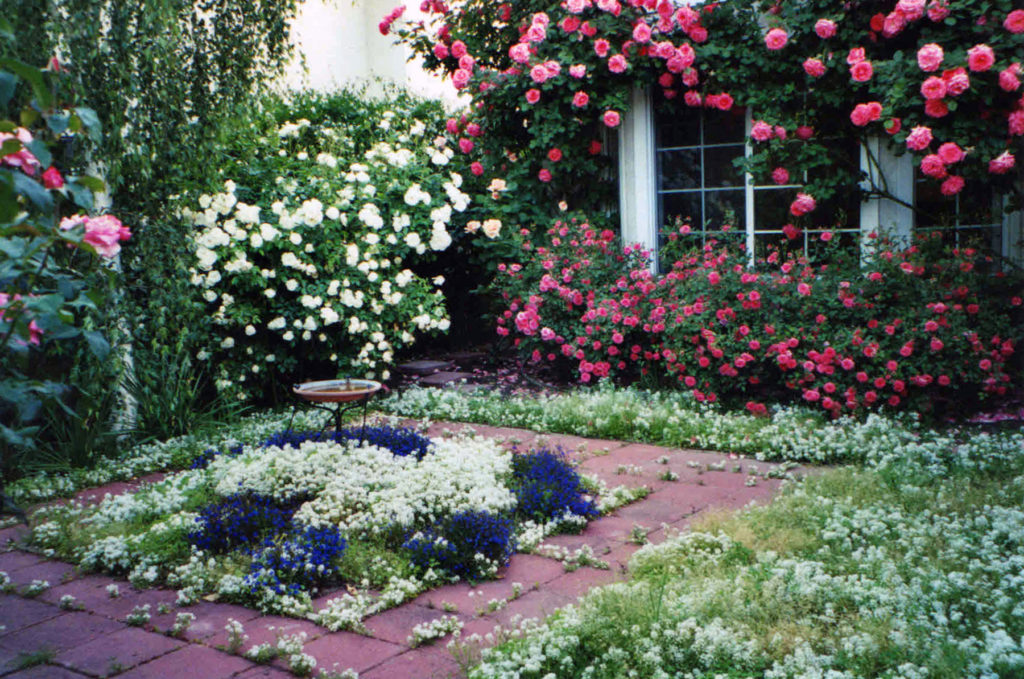Some time ago—after a peripatetic existence across the U.S., my native soil of India, and a few points in between—I get to put down roots for a while in a university town in northern California. Among other things, this means at last being in one place long enough to really grow a garden. Our house is surrounded by a pitilessly arid patch of ground razed so bare by construction crews that I keep standing aghast, trying to envisage what to do with it, until a visiting cousin is driven to ask: “Hey, are you surveying your acres again?”
The prospect, I tell her, is daunting even for my unpretentious patch. For more than a year we continue digging out handfuls of plaster and nails, despite amending the soil three times over. Everything must be learned from scratch in a totally new place suffering from a long drought, followed by seasons of flood. What is common knowledge to locals can descend like thunderclaps of insight or disaster on an ignorant head. I have no pride and ask everybody for advice: nursery staff, friends, plant encyclopedias, even casually encountered gardeners in their front yards who might be willing to stop for a chat, expounding on aquifers, xeriscapes and the like. In a burst of sanity I also volunteer at the University Arboretum to get a hands-on knowledge of local plants. Meanwhile an obliging neighbor lets himself be hired on occasion to help with digging trenches or planting heavy saplings.
There is also always the delight of poring over gardening books by wonderful writers. Not heavy-breathing “how-to” experts, but those who understand the simple measure of the human breath in every activity, and give it to us in good prose. Mirabel Osler’s A Gentle Plea for Chaos is an ally against rigidities—reminding us that in old China, leaves fallen from a tree would sometimes be left in their own untidily significant circle underfoot to reflect the outline of the branches overhead. In Onward and Upward in the Garden, Katherine S. White talks of how Spring brings catalogues that mesmerize you into trying all kinds of improbable schemes. She calls it “the season of lists and callow hopefulness” (in her marvelous nod to Keats’ season of mists and mellow fruitfulness.) Vita Sackvile-West’s Garden Book shares her planting notes on Chinese jasmine, Jasminum polyanthum. Flourishing here in Northern California, it has buds of magenta blossoming into white, and an almost overpowering scent. It also has twining and tenacious tendrils that can lead, as she says, to a lot of deadwood in the center and become “plaguey to control.” Her advice is to train some strong shoots sideways from the main stem—“otherwise we find ourselves with a task like unraveling several miles of mad hanks of string.” Often, at the end of a day, I’ve felt like a mad hank of string myself, but I love it.
I have come by that love honestly, if late: plants being one of the many facets of my parents’ unique companionship and meeting of minds. My mother has grown up with the daily plant lore of South India, my father has acquired his knowledge, patient and meticulous, all the way from Bombay—now called Mumbai—tenements to Cambridge University quads to national and international places of government. As children, a special birthday treat for my sister and me was planting a tree (with much help). Our parents themselves have grown what they can where they can, leaving everything behind for others, as my father is transferred from district to district and city to city. Wherever possible he volunteers at the local Horticultural Society, bringing in carefully permissible species from other parts of the world. On his retirement to Pune, about one hundred miles inland from Mumbai, my parents can at last grow their own garden with its produce always and unstintingly shared. In my mind, that garden hovers over my patch here like a composite image, summoned at will:
An improbable date palm outside the front gate. Five varieties of mango, seven kinds of coconut palms, both dwarf and full size, distributed along the edge of the compound and fed fish manure to sustain their seaside origins. Sandalwood (later to be a commodity stolen by criminal gangs). Lychee imports from China. Breadfruit, sending off root suckers in all directions. Custard apples (courtesy of seeds in bird droppings). Sapodillas, as they’re called in Central America and the Caribbean, but known here as chikkoo, sweet as sweet. Much-cherished curry-leaves; guavas; lemon grass; pomegranates displaying fruit and flower simultaneously; a barren avocado. Poinsettias growing at the base of the date palm, and reaching up, one December, almost as high as its top: scarlet leaves stippled sharp as blood against the mop-headed green above.
Flowering trees too. The rose and gold of Cassia javanica (aka Golden Shower elsewhere in the tropics) blossoming gloriously during April-May. A tall and eccentric Tabebuia rosea that blooms an unusual dark pink, whenever in season it wants to, and sometimes only along certain branches, like a dancer waving her arms. Plus innumerable smaller plants which include cuttings garnered on my father’s many walks and wanderings, snipped off by what we call his Sneaky Secateurs.
Among those five varieties of mango, the dussehri and the Alphonso are perhaps the most remarkable. Growing up in the far south, we have never known dussehris. Seeing depictions in northern miniatures, we presumed these to be stylized renditions of some perfectly conceived Platonic ideal of a mango tree. But there it is in full growth and detail right in front of our eyes. Graceful, endless droop of stems delineated against a cloudy billow of leaves, with the fruit pale and pendant below. Even the little boy who lives upstairs at this juncture, and is usually lively as a leveret, stands still to look. Following the inordinate length of the stems with his enormous eyes, he says: “Those mangoes have l-o-n-g tails.”
The Alphonso has yielded such a bounty of fruit over the years that my father suggests we perform a puja of thanks to it. Nothing elaborate, just a ritual awareness of all that attends the cultivation of a tree. Pruning, watering, fertilizing, breaking off dead twigs, making a berm if necessary, is as much a part of this puja as chanting a sloka to the life-giving centrality of the sun: as important to us as it is to every leaf. My father is gone now, and so is the garden; but that image and care of growing green continues to hover, continues to bless.
In trying to cultivate my place here, I have long conversations with Don and Nancy who run my favorite nursery in town. Don warns me about rampant Black Bamboo; Nancy says gardening is not a science, but an art. At first, struggling with the diabolical intricacies of our drip system, I’m not so sure. But then possibilities start to surface, usually by mistake. My designs result from making so many mistakes that necessity becomes not just the mother but the grandmother of invention. Yet this is preferable to professional landscape designs that have nothing to do with my purpose.

For me the whole process begins with a bhoomi puja, a private invocation as simple as my father’s, asking permission of this particular patch of earth to live on it: to have the grace to accept its gifts and the strength to withstand its hardships. I also want a palette that evokes—within my existing limits—the cross-cultural textures and resonances of other landscapes I have loved.
Where houses tend to stand cheek by jowl, the need for privacy demands a partially enclosed courtyard in front. And where your eye rises from the road up to the outer wall of this courtyard, a gentle slope lets me celebrate northern New Mexico. In the Taos valley aspens and cottonwoods turn an incandescent gold in the Fall, intensifying the blue of the mountains into a deep drenched purple. The entire mesa below spreads like an ocean, picking up the same two colors: chamisa and rabbit brush bursting into sunlit yellow, with scarves of blue asters flung between them, across illimitable distances. It’s the kind of expanse that makes you breathe with your whole life. Here my minor juxtapositions of golden Sweet Broom, French lavender and blue hibiscus may seem like very small delusions of all that grandeur, but they try. The blue hibiscus (Alogyne heugli) is not a hibiscus at all; yet its petals reflect the magically faint enamel sheen of flowers in illuminated medieval manuscripts.
Shading all these, the Chinese tallow tree (Sapium sebiforum) and a Chinese pistache answer other autumns. The latter also answers botanical homesickness, since the fretted delicacy of its leaves in the wind reminds me of our neem in India. (Down the centuries those bitter leaves have been soaked in hot water for a mother’s first bath after childbirth; today neem extract remains an ingredient in shampoos, its twigs—a reliable old dentifrice—still used in toothpaste.)
Meanwhile the courtyard itself begins with the usual mistakes. Its central patio floor overheats—some tiles have to be removed—yielding a strangely integrated pattern—and somehow a mandala evolves in the open space within a planned rose garden. Right in the exact center, like the cosmic dot in Tantric imagery, stands a simple round turquoise-and-terra-cotta bird bath. Shamelessly mixing more cross-cultural metaphors, in my mind its terra cotta echoes Tanagra figurines; its turquoise tone merges into Mughal and Persian blues.
The human make-up of our neighborhood affirms this aspect of my planting. In addition to long-term Californians, we have mainland Chinese to our left; for two years a Pakistani family to our right, with whom to chatter in Hindi or Urdu; further down, a young couple from my childhood stomping ground in the far south of the subcontinent who almost keel over from shock when addressed in Tamil from behind the bush I’m weeding. At one end of our curving block are my French gardening friend and her American husband, and at the other, two Mexican families who grow the most blissfully beautiful roses. Walking past one day we hear strains of mariachi music floating from the windows and find a group of young people in front of their house dancing what looks like a combination minuet and Mexican waltz: gravely touching hands and turning and bowing to each other under a lambent evening sky—all of which is a further incentive to bring some of what’s inside my skull to what’s sustainable in this one place. If Sacred or Heavenly Bamboo (Nandina domestica) is considered auspicious in Japan, I plant it in welcome on either side of our front door. Papyrus, with its echoes of Egypt and ancient paper, thrives in areas lacking good drainage, where the soil stays moist while everything else bakes.
Inspiration sprouts everywhere. Lady Murasaki’s Tale of the Genji about 11th century court life in Japan (which begins by her saying “My thoughts this morning are as tangled as my hair–”) describes extraordinary ‘moon-viewing’ gatherings to see white flowers by moonlight. Her images at once flood my concept of whites along the whole west fence: an ‘Iceberg’ rose; the pallor of a flowering potato vine (Solanum jasminoides); white tulips, daffodils, narcissus, blooming in turn on a silvery ground cover of Lamium maculatum scattered with Snow-in-Summer. All these get punctuated by the trunks of graceful white birches which have to be babied along in this inhospitable zone. Hosing them down at night to keep them cool, I am asked if I’ll be changing their diapers next. Inevitably, almost everything is washed away during the next flood, even if we are only at its periphery. No more moon-viewing. Vegetables in back are gone too, though the grape vines make it.
In this area at this time, wonderful Farmers Markets do return and revive; open trucks of produce spill a few tomatoes while taking a curve; and a weevil walks across my computer screen as I write.
That cosmic dot in the courtyard has now been surrounded by a Mystic Spiral of lobelias and white alyssum. Lobelias, let’s not forget, were brought to the northern hemisphere from the southernmost tip of the African continent and named after Mathias de l’Obel, physician to England’s James I.
“Why do they have to keep changing names?” an indignant friend demands. “Why can’t they respect the original and stick to it?” Why not indeed: except for clumsy tongues and naming a thing to make it yours. Etymology can be a fascinating companion in a garden.
So can fragrance. One day in early Spring when jasmine, roses and sweet alyssum are all showing off at the same time, our mail person delivers a package, sniffs luxuriously, and says: “Aromatherapy! I needed that.”
In my mother tongue we say a dish without spices is like a child without parents. Roses without fragrance fall into that category. The faintest scent here belongs to the Lady Banks Rose, which threatens to take over most of the wooden back fence (including the branches of a beautiful Cinnamon Camphor tree, planted first, whose crushed leaves smell of both ingredients.)
Rosa banksiae is originally a wild rose from the Yunnan province of China. A doughty Brit surnamed Forrest found it while wandering around two-hundred-odd years ago in the Lijiang Valley, where it is used as a hedge. I get lured by seeing an old photograph of it there in that remote valley rimmed by smoky strangely shaped mountains– its graceful arching canes, seven slender pointed leaflets, and curiously backward-curving thorns. A more accessible double variety is brought back from Canton to Kew Gardens in 1807 and named (I can hear my friend’s hackles rising) after the wife of its then Director.
Our French neighbor, who has long been familiar with this double variety, says its yellow form was first cultivated in Europe at Versailles, while the white which I yearn for flourishes here. So I get it and grow it, tracing its journey from China to Kew Gardens to my neighbor’s French childhood to this backyard in California. It’s like touching the world when you touch a petal.
Of course this can happen in more serious ways. A psychotherapist I know works with harrowingly traumatized refugees: as one of the steps toward healing, she encourages them to plant whatever they want to in the community garden she has organized. Many of us in far less dire circumstances have experienced the therapeutic value of getting our hands in the dirt. I for one start growing roses for the first time after getting some terrible news from India, about which I can do nothing—except grow roses.

Two identical old-fashioned David Austins have been planted at the entrance, just inside and outside the courtyard wall, so they can spill continuously over it—allowing the eye to rest on them a moment, before moving from the blues and golds of New Mexico beyond the courtyard to the range of roses blooming within, and then climbing in tones of coral up the front of the house.
This alternation of rest and continuity becomes necessary when trying to transform a small or medium size area into a fluid space. That space may widen implicitly into cross-cultural contexts, but—as in any planting, anywhere, for any need—the one basic that cannot be side-stepped is time and timing. Recalling Nancy’s comment at the nursery about gardening as art, I realize this is more than a question of color and shape and placement. It’s like finding the linked syllables of a perfect phrase: to celebrate the ephemeral as well as the enduring.
We wanderers and unprofessional garden designers have to keep tabs on that. You don’t quite know what you are doing until you see what you have done, five years later. If you are lucky. And still happen to be living in the same place. Yet my effort does remind me that sometimes, in going from here to there, you can reach an abiding everywhere. ♦
If you have enjoyed this piece, consider subscribing.

